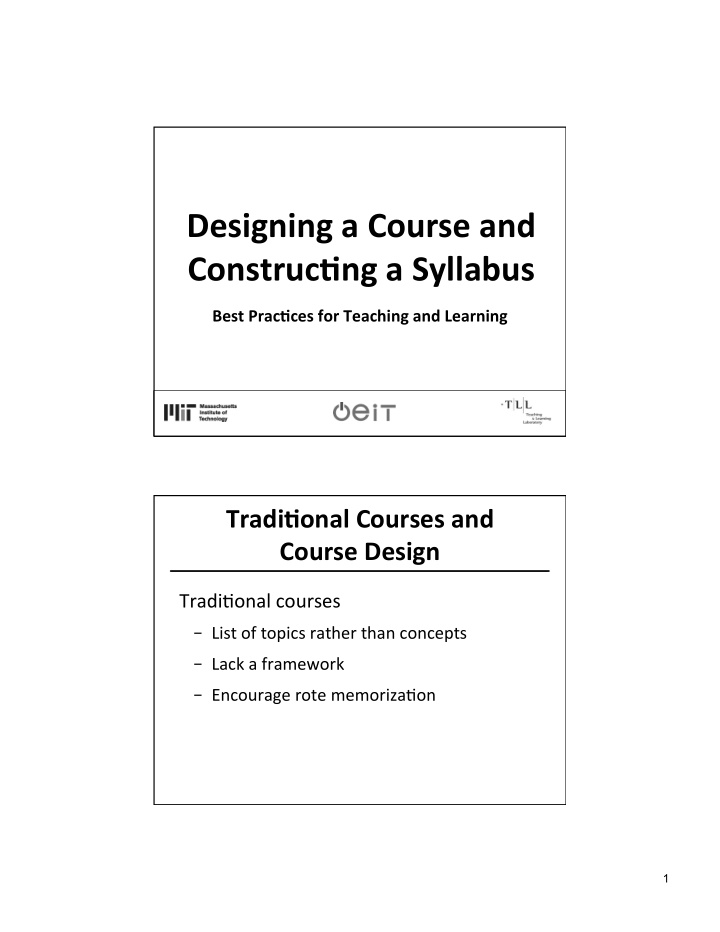



Designing ¡a ¡Course ¡and ¡ Construc0ng ¡a ¡Syllabus ¡ Best ¡Prac0ces ¡for ¡Teaching ¡and ¡Learning ¡ Tradi0onal ¡Courses ¡and ¡ Course ¡Design ¡ Tradi&onal ¡courses ¡ – List ¡of ¡topics ¡rather ¡than ¡concepts ¡ – Lack ¡a ¡framework ¡ – Encourage ¡rote ¡memoriza&on ¡ 1
Tradi0onal ¡Courses ¡and ¡ Course ¡Design ¡ The ¡result ¡is ¡that: ¡ – Knowledge ¡is ¡acquired ¡without ¡a ¡connec&ng ¡ framework ¡and ¡does ¡not ¡lead ¡to ¡ understanding ¡ – Learning ¡has ¡li=le ¡reward ¡ – No ¡transfer ¡of ¡knowledge ¡ Knowledge ¡≠ ¡Understanding ¡ ¡ “What ¡differen&ates ¡revolu&onary ¡thinkers ¡from ¡ non-‑revolu&onary ¡ones ¡is ¡almost ¡never ¡a ¡greater ¡ knowledge ¡of ¡the ¡facts, ¡Darwin ¡knew ¡far ¡less ¡about ¡ the ¡various ¡species ¡he ¡collected ¡on ¡the ¡Beagle ¡ voyage ¡than ¡did ¡experts ¡back ¡in ¡England ¡who ¡ classified ¡these ¡organisms ¡for ¡him. ¡Yet ¡expert ¡aMer ¡ expert ¡missed ¡the ¡revolu&onary ¡significance ¡of ¡ what ¡ Darwin ¡collected, ¡who ¡ knew ¡less, ¡somehow ¡ understood ¡more .” ¡ Sulloway, F.J., Born to Rebel , p.20 2
Goal ¡ To ¡illustrate ¡how ¡ backward ¡course ¡design ¡ can ¡lead ¡to ¡a ¡more ¡effec&ve ¡course. ¡ Learning ¡Objec0ves ¡ By ¡the ¡end ¡of ¡this ¡session, ¡you ¡will ¡have ¡considered ¡ways ¡to: ¡ 1. State ¡the ¡components ¡of ¡a ¡syllabus ¡ 2. Iden0fy ¡the ¡components ¡of ¡Backward ¡Course ¡Design: ¡ Evaluate ¡content ¡for ¡a ¡course ¡you ¡would ¡like ¡to ¡teach ¡ 3. based ¡on ¡content ¡priori&es ¡ 4. Define ¡and ¡develop ¡learning ¡objec&ves ¡for ¡a ¡course ¡you ¡ would ¡like ¡to ¡teach ¡ 3
What ¡exactly ¡is ¡a ¡syllabus? ¡ A ¡“roadmap” ¡for ¡the ¡course ¡ ¡ – Where ¡you ¡are ¡going ¡during ¡the ¡semester ¡ – Why ¡you ¡are ¡going ¡there ¡ – How ¡you ¡are ¡geRng ¡there ¡ A ¡contract ¡between ¡the ¡instructors ¡and ¡the ¡students ¡ – Explicit ¡ – Implicit ¡ What ¡exactly ¡is ¡a ¡syllabus? ¡ ¡ “A ¡good ¡syllabus ¡is ¡… ¡evidence ¡that ¡you ¡have ¡ devoted ¡the ¡essen&al ¡effort ¡needed ¡to ¡ create ¡a ¡good ¡course; ¡a ¡bad ¡syllabus ¡is ¡ students’ ¡first ¡warning ¡that ¡you ¡haven’t ¡and ¡ that ¡your ¡course ¡is ¡likely ¡to ¡disappoint.” ¡ “What’s in a syllabus?” by Prof. Michael Shafer, Political Science, Rutgers University 4
What’s ¡in ¡a ¡syllabus? ¡ The ¡core ¡of ¡the ¡explicit ¡contract: ¡ – Basic ¡course ¡informa&on ¡ – Descrip&on ¡ – Goals ¡and ¡learning ¡objec&ves ¡ – Assessments ¡ – Schedule ¡ – Policies ¡ What’s ¡in ¡a ¡syllabus? ¡ The ¡core ¡of ¡the ¡implicit ¡contract: ¡ Norms ¡may ¡evolve ¡during ¡the ¡first ¡few ¡weeks ¡ of ¡the ¡semester. ¡ – Who ¡talks ¡in ¡the ¡classroom, ¡when, ¡and ¡for ¡ how ¡long? ¡ – How ¡are ¡strict ¡are ¡the ¡assignment ¡deadlines? ¡ – What ¡is ¡the ¡nature ¡of ¡the ¡rela&onship ¡between ¡ the ¡students ¡and ¡instructor? ¡Between ¡students? ¡ ¡ 5
The ¡Backward ¡Design ¡Process ¡ Learning ¡ Learning ¡ Assignments ¡& ¡ Experiences ¡& ¡ Objec0ves ¡ Exams ¡ Instruc0on ¡ What ¡is ¡ How ¡do ¡you ¡ How ¡do ¡you ¡ important? ¡ know ¡if ¡they ¡ help ¡them ¡ ¡ get ¡it? ¡ get ¡it? ¡ GOALS ¡ ASSESSMENT ¡ PRACTICE ¡ Modified from Wiggins & McTighe, Understanding by Design, p. 18 The ¡Elements ¡of ¡ Backward ¡Design ¡ GOALS: ¡ – Consider ¡students’ ¡skills, ¡knowledge, ¡& ¡aRtudes ¡to ¡ develop ¡learning ¡objec&ves. ¡ ASSESSMENT: ¡ – Assess ¡students’ ¡abili&es ¡to ¡meet ¡the ¡learning ¡ objec&ves, ¡both ¡at ¡the ¡beginning ¡and ¡throughout ¡the ¡ course. ¡ PRACTICE: ¡ – Design ¡in-‑class ¡ac&vi&es ¡and ¡instruc&onal ¡methods ¡to ¡ help ¡students ¡meet ¡the ¡learning ¡objec&ves. ¡ Wiggins & McTighe, Understanding by Design, p. 18 6
Content ¡Priori0es ¡ Worth ¡Being ¡ ¡ Familiar ¡With ¡ Important ¡to ¡ Know ¡& ¡Do ¡ Big ¡Ideas ¡ ¡ & ¡Core ¡ Tasks ¡ Wiggins & McTighe, Understanding by Design, p. 71 Pair-‑Share ¡Ac0vity ¡ What ¡are ¡the ¡ big ¡ideas ¡ within ¡your ¡discipline? ¡ 7
Big ¡Ideas ¡ ¡ Physics : ¡Energy ¡conserva&on ¡ Biology : ¡Evolu&onary ¡mechanisms ¡ Chemistry : ¡Structure ¡and ¡func&on ¡ ¡ Mathema0cs : ¡Divide ¡and ¡conquer ¡ Signals ¡& ¡Systems : ¡Feedback ¡loops ¡ Think-‑Pair-‑Share ¡Ac0vity ¡ • Iden0fy ¡the ¡underlying ¡concepts ¡of ¡the ¡ topics ¡ • Priori0ze ¡the ¡content ¡into ¡the ¡3 ¡ categories ¡of ¡content ¡priori&za&on: ¡ 1. Big ¡Ideas ¡& ¡Core ¡Tasks ¡ 2. Important ¡to ¡Know ¡and ¡Do ¡ 3. Worth ¡Being ¡Familiar ¡With ¡ 8
Discussion ¡ • What ¡were ¡your ¡reac&ons ¡to ¡the ¡ readings? ¡ • Do ¡you ¡have ¡any ¡ques&ons ¡about ¡the ¡ readings? ¡ Learning ¡Objec0ves: ¡S-‑K-‑A ¡ By ¡the ¡end ¡of ¡the ¡course, ¡ Skills ¡ – What ¡should ¡students ¡be ¡able ¡to ¡do? ¡ Knowledge ¡ – What ¡should ¡students ¡know ¡and ¡understand? ¡ A]tudes/A_ributes ¡ – What ¡aRtudes ¡or ¡a=ributes ¡should ¡students ¡have? ¡ ¡ 9
Learning ¡Objec0ves: ¡S-‑K-‑A ¡ Learning ¡objec&ves ¡are: ¡ – Statements ¡describing ¡a ¡ specific , ¡ observable , ¡ and ¡ measurable ¡student ¡behavior. ¡ ¡ Learning ¡objec&ves ¡are ¡NOT: ¡ – A ¡list ¡of ¡topics ¡to ¡be ¡covered, ¡ – Ac&ons ¡to ¡be ¡performed ¡by ¡the ¡instructor, ¡or ¡ – What ¡you ¡hope ¡students ¡get ¡from ¡the ¡course. ¡ Bloom’s ¡Taxonomy ¡ Create ¡ Evaluate ¡ Analyze ¡ Apply ¡ Understand ¡ Remember ¡ Bloom (1956), Anderson et al (2001) 10
Think-‑Pair-‑Share ¡Ac0vity ¡ Based ¡on ¡the ¡topics ¡you ¡iden&fied ¡in ¡your ¡ pre-‑session ¡assignment, ¡ ¡ – iden0fy ¡the ¡underlying ¡concepts ¡and ¡ skills, ¡and ¡ – write ¡intended ¡learning ¡objec&ves ¡ ¡ for ¡the ¡course ¡that ¡you ¡teach ¡or ¡would ¡like ¡ to ¡teach. ¡ ¡ ¡ Summary ¡ • Components ¡of ¡a ¡syllabus ¡ • Course ¡Design ¡ – Backward ¡Design ¡ – Content ¡Priori&za&on ¡ – Learning ¡Objec&ves ¡ 11

Recommend
More recommend